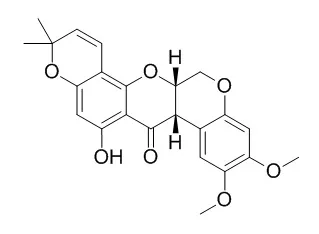| In vitro: |
| J Nat Prod. 2003 Sep;66(9):1166-70. | | Potential cncer chemopreventive flavonoids from the stems of Tephrosia toxicaria.[Pubmed: 14510590 ] |
METHODS AND RESULTS:
A new butenylflavanone, (2S)-5-hydroxy-7-methoxy-8-[(E)-3-oxo-1-butenyl]flavanone (1), and a new rotenoid, 4',5'-dihydro-11,5'-dihydroxy-4'-methoxytephrosin (2), as well as three active flavonoids of previously known structure, isoliquiritigenin (3), genistein (4), and chrysoeriol (5), along with nine known inactive compounds, Alpha-Toxicarol (6), sumatrol, 6a,12a-dehydro-Alpha-Toxicarol, 11-hydroxytephrosin, obovatin, marmesin, lupenone, benzyl benzoate, and benzyl trans-cinnamate, were isolated from an ethyl acetate-soluble extract of the stems of Tephrosia toxicaria, using a bioassay based on the induction of quinone reductase (QR) in cultured Hepa 1c1c7 mouse hepatoma cells to monitor chromatographic fractionation. The structures of compounds 1 and 2 were elucidated by spectroscopic data interpretation.
CONCLUSIONS:
All isolates were evaluated for their potential cancer chemopreventive properties utilizing an in vitro assay to determine quinone reductase induction. Selected compounds were tested in a mouse mammary organ culture assay to evaluate the inhibition of 7,12-dimethylbenz[a]anthracene (DMBA)-induced preneoplastic lesions. | | J Agric Food Chem. 2012 Oct 10;60(40):10055-63. | | Highly variable insect control efficacy of Tephrosia vogelii chemotypes.[Pubmed: 22970736 ] | Tephrosia vogelii has been used for generations as a pest control material in Africa.
METHODS AND RESULTS:
Recently, two chemotypes have been reported based on the occurrence (chemotype 1) or absence (chemotype 2) of rotenoids. This could have an impact on the efficacy and reliability of this material for pest control. We report that chemotype 2 has no pesticidal activity against Callosobruchus maculatus Fabricius (family Chrysomelidae) and that this is associated with the absence of rotenoids.
CONCLUSIONS:
We present a first report of the comparative biological activity of deguelin, tephrosin, α-toxicarol, and sarcolobine and show that not all rotenoids are equally effective. Tephrosin was less toxic than deguelin which was less active than rotenone, while obovatin 5-methyl ether, the major flavonoid in chemotype 2 was inactive. We also report that in chemotype 1 the occurrence of rotenoids shows substantial seasonal variation. | | Planta Med. 2004 Jun;70(6):585-8. | | Cancer chemopreventive activity of rotenoids from Derris trifoliata.[Pubmed: 15229812 ] | A study of the chemical constituents of the stems of Derris trifoliata Lour. (Leguminosae) led to the isolation and identification of one new rotenoid, 6aalpha,12aalpha-12a-hydroxyelliptone ( 3), together with five other known rotenoids.
METHODS AND RESULTS:
In a search for novel cancer chemopreventive agents (anti-tumor promoters), we carried out a primary screening of five of the rotenoids isolated from the plant for their inhibitory effects on Epstein-Barr virus early antigen (EBV-EA) activation induced by 12- O-tetradecanoylphorbol 13-acetate (TPA) in Raji cells. The inhibitory activity of 3 was found to be equivalent to that of beta-carotene without any cytotoxicity.
CONCLUSIONS:
Deguelin ( 4) and Alpha-Toxicarol ( 5) exhibited a marked inhibitory effect on mouse skin tumor promotion in an in vivo two-stage carcinogenesis test. This investigation indicated that rotenoids might be valuable anti-tumor promoters. |
|






 Cell. 2018 Jan 11;172(1-2):249-261.e12. doi: 10.1016/j.cell.2017.12.019.IF=36.216(2019)
Cell. 2018 Jan 11;172(1-2):249-261.e12. doi: 10.1016/j.cell.2017.12.019.IF=36.216(2019) Cell Metab. 2020 Mar 3;31(3):534-548.e5. doi: 10.1016/j.cmet.2020.01.002.IF=22.415(2019)
Cell Metab. 2020 Mar 3;31(3):534-548.e5. doi: 10.1016/j.cmet.2020.01.002.IF=22.415(2019) Mol Cell. 2017 Nov 16;68(4):673-685.e6. doi: 10.1016/j.molcel.2017.10.022.IF=14.548(2019)
Mol Cell. 2017 Nov 16;68(4):673-685.e6. doi: 10.1016/j.molcel.2017.10.022.IF=14.548(2019)